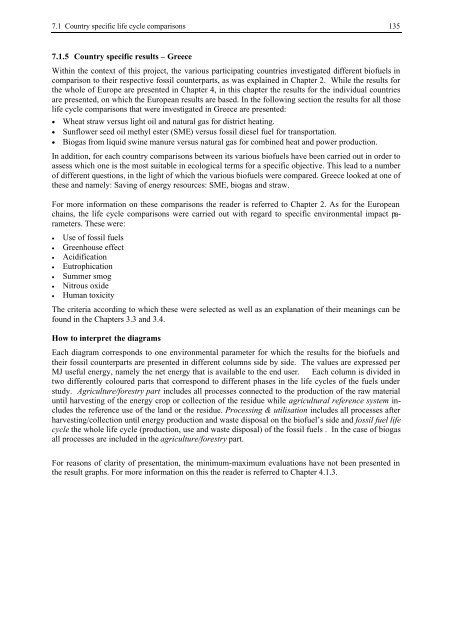BIOENERGY FOR EUROPE: WHICH ONES FIT BEST?
BIOENERGY FOR EUROPE: WHICH ONES FIT BEST?
BIOENERGY FOR EUROPE: WHICH ONES FIT BEST?
Create successful ePaper yourself
Turn your PDF publications into a flip-book with our unique Google optimized e-Paper software.
7.1 Country specific life cycle comparisons 135<br />
7.1.5 Country specific results – Greece<br />
Within the context of this project, the various participating countries investigated different biofuels in<br />
comparison to their respective fossil counterparts, as was explained in Chapter 2. While the results for<br />
the whole of Europe are presented in Chapter 4, in this chapter the results for the individual countries<br />
are presented, on which the European results are based. In the following section the results for all those<br />
life cycle comparisons that were investigated in Greece are presented:<br />
• Wheat straw versus light oil and natural gas for district heating.<br />
• Sunflower seed oil methyl ester (SME) versus fossil diesel fuel for transportation.<br />
• Biogas from liquid swine manure versus natural gas for combined heat and power production.<br />
In addition, for each country comparisons between its various biofuels have been carried out in order to<br />
assess which one is the most suitable in ecological terms for a specific objective. This lead to a number<br />
of different questions, in the light of which the various biofuels were compared. Greece looked at one of<br />
these and namely: Saving of energy resources: SME, biogas and straw.<br />
For more information on these comparisons the reader is referred to Chapter 2. As for the European<br />
chains, the life cycle comparisons were carried out with regard to specific environmental impact parameters.<br />
These were:<br />
• Use of fossil fuels<br />
• Greenhouse effect<br />
• Acidification<br />
• Eutrophication<br />
• Summer smog<br />
• Nitrous oxide<br />
• Human toxicity<br />
The criteria according to which these were selected as well as an explanation of their meanings can be<br />
found in the Chapters 3.3 and 3.4.<br />
How to interpret the diagrams<br />
Each diagram corresponds to one environmental parameter for which the results for the biofuels and<br />
their fossil counterparts are presented in different columns side by side. The values are expressed per<br />
MJ useful energy, namely the net energy that is available to the end user. Each column is divided in<br />
two differently coloured parts that correspond to different phases in the life cycles of the fuels under<br />
study. Agriculture/forestry part includes all processes connected to the production of the raw material<br />
until harvesting of the energy crop or collection of the residue while agricultural reference system includes<br />
the reference use of the land or the residue. Processing & utilisation includes all processes after<br />
harvesting/collection until energy production and waste disposal on the biofuel’s side and fossil fuel life<br />
cycle the whole life cycle (production, use and waste disposal) of the fossil fuels . In the case of biogas<br />
all processes are included in the agriculture/forestry part.<br />
For reasons of clarity of presentation, the minimum-maximum evaluations have not been presented in<br />
the result graphs. For more information on this the reader is referred to Chapter 4.1.3.

















